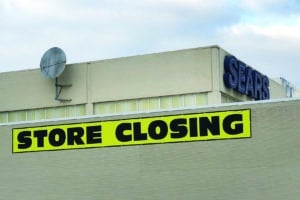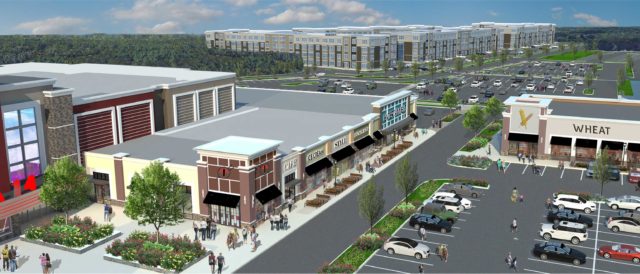
A “store closing” banner hangs on a Michigan Sears store in November 2018. Sears, Macy’s other chains announced they shuttered Massachusetts stores totaling more than 1 million square feet of retail space in 2018.
The Great Retail Apocalypse has finally hit Greater Boston, with the meltdown of major chains ranging from Sears and Payless to Papa Gino’s hitting home in malls and shopping centers across the region.
Driven in part by the rise of e-commerce, this latest manifestation of the creative destruction of capitalism has the potential to dramatically reshuffle the retail landscape across the region. It follows in the wake of national trends, which have seen thousands of store closings over the past few years.
While the urban core in Boston and its environs appears poised for continued growth amid an explosion of luxury condominium and apartment towers, it’s a different picture in the suburbs, where the loss of major anchor stores is hitting the hardest.
Towns from Peabody to Natick could face a loss of precious commercial tax revenue as suburban malls struggle to stay viable and relevant, and to find anchor tenants.
“We have seen [retail] vacancies rise for the first time this cycle,” noted CoStar New England analyst Peter Conway, who laid out the figures in a recent report. “This is due to several store closing,” he said, adding it is “notable rise.”
1M SF Closed in 2018
The first two months of 2019 saw major chains announce 440,000 square feet of store and restaurant closures in the Boston area, more than in all of 2017, which totaled 360,000 square feet, according to CoStar.
If present trends continue, 2019’s closings will also likely blow past 2018’s already formidable numbers, a year in which Sears, Macy’s other chains announced they would be shuttering area stores totaling more than 1 million square feet of retail space.
The store closings are already having a measurable impact, slowing down retail rent growth in the Boston area to 1.7 percent, down from its previous pace of 2.9 percent, while also pushing up retail vacancy rates by 50 basis points, CoStar notes.

Scott Van Voorhis
Large stores have dominated the closings, with those 50,000 square feet or larger making up half of the retail outlets shuttered since 2017, according to CoStar.
Sears has led the way, with 450,000 feet of store closings, including anchor locations in the Natick Mall and the CambridgeSide mall. Macy’s and Toys ‘R’ Us have combined for another 550,000 square feet.
There’s also Shaw’s, which has announced plans to close four stores – or 150,000 square feet – and struggling Papa Gino’s, whose 56 locations could put 150,000 square feet of retail space on the market, CoStar reports.
Other, smaller stores have also closed, with the 22,000–square–foot American Girl Doll Store in the Natick Mall a prime example.
Retail to Grow in Urban Core
Mall owners are already scrambling to adapt, with National Development moving ahead with plans to convert the Sears store at CambridgeSide into office space, which is likely to rent easily given demand from the red–hot Kendall Square, which is right next door.
In fact, if anything urban retail is poised for more growth, with developers scrambling to put in new shops and restaurants and grocery stores in fast-growing neighborhoods like the Seaport.
Boston has been under-retailed for years; city planners have spent years pushing to bring in new grocery stores to serve fast-growing residential areas in and around downtown Boston, CoStar’s Conway notes.
That push has paid off, as the number of grocery stores in Boston and beyond has jumped 15 percent since 2007, compared to 3 percent growth nationally. Restaurants are up 18 percent, compared to 14 percent nationally, according to CoStar.
It’s the suburbs that now have too much retail space, especially as shoppers continue to spend more money and time online with Amazon and other web alternatives.
While e–commerce still only accounts for 10 percent of the market in the U.S., it is growing at 15 percent a year. And based on the experience of other nations like China, where 23 percent of all retail sales now takes place online, CoStar reports that trend could easily continue.

The owners of the Hannover Mall are proposing to add 297 units of housing at a separate lot on the mall’s grounds as part of an effort to diversify their struggling property.
How to Replace an Anchor
Finding new uses for empty Sears and Macy’s stores is likely to prove a big challenge.
Traditional department stores are on the wane, while subdividing these big footprints could also prove to be expensive and/or impractical.
The era of the suburban mall is fading as technology changes shopping habits and wealth and demographics increasingly favor urban locations.
The big suburban malls may very well follow the downward path to oblivion that Main Street shops and retailers were consigned to after the rise of the suburbs and two-car families in the 1950s and ’60s.
Worst case, empty big box stores may someday dot the landscape as silent reminders of the remorseless pace of economic and technological change, much as the empty red brick mills of Lawrence and Lowell stand as monuments to New England’s nearly extinct textile industry.
Hopefully, mall owners, developers and local officials will rise to the challenge. The region’s dire shortage of housing offers an obvious possibility, although the NIMBYs will surely push back against any change.
Apartments, anyone?
Scott Van Voorhis is Banker & Tradesman’s columnist; opinions expressed are his own. He may be reached at sbvanvoorhis@hotmail.com.




 |
| 
